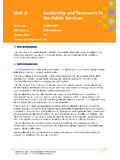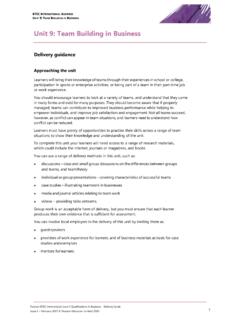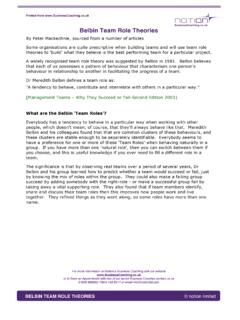Transcription of The Myths and Realities of Teamwork
1 The Myths and Realities of Teamwork Page 1 The Myths and Realities of Teamwork By David Wright, Wright Consultancy Limited, About the book In this book, the author, David Wright, sets out to share 30 years of his team building experience in organisations both large and small. The book focuses on the key milestones that mark a team s journey to high performance, without being na ve to the challenges and the pitfalls; hence the title The Myths and Realities of Teamwork . The most common myth is that there is no I in team; however, there is a me . The reality is that the reader can never ignore an individual s needs, even within a strong team environment. The Myths and Realities of Teamwork will be told through a series of milestones (chapters) on a journey to high performance using 32 case studies, 37 illustrations and one joke, but it is a good one.
2 The milestones highlighted within each chapter, will aid the reader to check the team s progress. The initial part of the team journey will focus on basic steps in building the team and this may feel mechanistic; however, as the book unfolds, you will experience more challenging skills and processes that will enable you and your team to achieve high performance. The Myths and Realities are visited throughout the book to assist the reader to be realistic in approach. The book also aims to help mature teams recapture that early enthusiasm and respect you may have witnessed when the team was new. Building a really effective team is akin to taking a journey and members of the team must experience the journey together. I will refer to the team journey a lot throughout this book.
3 In order for the team to have a fruitful journey, the following milestones must be reached: ! Burying the Myths and raising the Realities ! Understanding organisation culture and the team s potential starting point ! Establishing team goals and vision ! Establishing ground rules for effectiveness ! Meeting skills and positive contributions ! Recognising the team processes including the journey from Ritual Sniff to Maturity ! Developing team skills that will aid success ! Defining the team roles beyond pure functional roles and predicting future success or failure ! Understanding empowerment and its place, especially in self-directed work teams ! Having the level of openness and trust to share feelings and take responsibility for change !
4 Embracing high performance, celebration and fun ! Understanding the practice of leadership for all. The Myths and Realities of Teamwork Page 2 Chapter 1 Myths and Realities of Teamwork The purpose of this introduction is to ensure the reader is not na ve about the challenges and the rewards that lie ahead. Teamwork , when introduced for the right reasons and managed in a challenging way, is one of most rewarding processes any manager or leader can experience. Myths and Realities of Teamwork are examined under six headings: The Myth Teamwork The Reality Teams are harmonious people who compromise their needs for the sake of the team Good teams are made of diverse people with specific needs to be met. The team s diversity can be a strength There is no I in TEAM but there is a ME and ignore the ME at your peril Team conflict is unhealthy Conflict can be healthy and should be harnessed for the common good, rather than suppressed.
5 Conflict is an energy source so harness it Most people like Teamwork My observations suggest that about one third of the working population enjoy Teamwork , one third are indifferent and one third prefer to work solo Teamwork is essential to business success Teams thrive on complexity; however, if a task or process is simple an organisation can cope without Teamwork Teams are easy to influence and manage Teamwork requires courage and high levels of personal awareness from its leaders Senior Managers encourage Teamwork Most senior managers fear teams and the potential loss of power or control To aid understanding, the six Myths will be explored by focusing on the Realities of Teamwork in the paragraphs below. The Myths and Realities of Teamwork Page 3 Myth 1 - Teams are generally harmonious people who compromise their needs for the sake of the team Good teams are made of diverse people with specific needs to be met within the team.
6 When the diversity is recognised and utilised appropriately the team s diversity can become a team strength. A starting point for working with any team is to understand the individuals that work in the team. There are many instruments on the market to help identify a team s profile. The key is not to label people or the team but allow the team to: Identify the range of talents within the team and encourage the team members to recognise and use that talent to help the team succeed Predict the team s overall performance and identify strengths and weaknesses Write a set of team ground rules for operating as a team that will aid success Having a team of the same profile is often a barrier to future success. When any one profile type dominates a team, the team usually underperforms.
7 For example, it is easy to predict what will happen when a team is dominated by any of the four main team profiles (see Fig under meth 3): Task focused team: if planning is defined as quality of thought before action, the task dominated team will fail to do the right thing and a team s high level of activity is often confused with success. Ideas focused team: experience low follow-through on ideas or innovations and become distracted by the excitement of the next new idea, rather than relevant outputs. Analytical focused team: often demonstrate poor differentiation between important and unimportant tasks leading to poor decision making and inflexibility. Socially focused team: demonstrate great fun and concern for each other; however, they can lack a sense of urgency leading to low output and missed deadlines.
8 If the diverse profile within a team can be recognised and utilised appropriately, the team members will deliver team success. This diversity is to be seen as a strength. Failure to recognise the diversity can lead to team chaos. The Myths and Realities of Teamwork Page 4 Myth 2 - Team conflict is unhealthy Conflict within teams needs to be recognised as a positive energy source, especially if the whole team can embrace the team s primary goal or mission rather than individual goals. A good definition of a team is: A group of individuals who are passionate about a common goal. The word passionate is important, because it is the passion for the common goal that is the glue that keeps the team together. The passion for a common goal allows conflict to be seen in a positive light, as the fight is about achieving the objective and not with each other.
9 Choosing the right goal is important to success. Also the goal should be challenging so that the team recognises that it will only be achieved with the engagement of the full team. There are a number of ways teams can anticipate conflict and deal with it early and appropriately: As a first step we encourage teams to write a set of ground rules for how the team will operate. Inevitably the word respect will appear, however, in support of respect the team needs to learn the skills of giving and receiving feedback and take responsibility for their actions. Regular and open reviews of how the team is progressing on its goals and adhering to its ground rules must be put into place. Direct and unambiguous language is also important.
10 For some teams in their early stages of formation I recommend only using the word we when celebrating success, use the words I and you when talking about their own and the team s performance. Personal conflict around individuals should not be tolerated as it breaches the respect ground rule and possibly the passion for the common goal. Conflict within a team should be seen as positive. Examples of reasons why conflict should be seen as good for the team progress and growth are: Conflict is an energy source of excitement and it should be harnessed for the common good. The opposite of conflict is apathy and this is the real danger to a team. Conflict helps the thinking within the team, removing the blinkers and on occasion leading to creativity.






